Yilun Liu
R1-T1: Fully Incentivizing Translation Capability in LLMs via Reasoning Learning
Feb 27, 2025Abstract:Despite recent breakthroughs in reasoning-enhanced large language models (LLMs) like DeepSeek-R1, incorporating inference-time reasoning into machine translation (MT), where human translators naturally employ structured, multi-layered reasoning chain-of-thoughts (CoTs), is yet underexplored. Existing methods either design a fixed CoT tailored for a specific MT sub-task (e.g., literature translation), or rely on synthesizing CoTs unaligned with humans and supervised fine-tuning (SFT) prone to catastrophic forgetting, limiting their adaptability to diverse translation scenarios. This paper introduces R1-Translator (R1-T1), a novel framework to achieve inference-time reasoning for general MT via reinforcement learning (RL) with human-aligned CoTs comprising six common patterns. Our approach pioneers three innovations: (1) extending reasoning-based translation beyond MT sub-tasks to six languages and diverse tasks (e.g., legal/medical domain adaptation, idiom resolution); (2) formalizing six expert-curated CoT templates that mirror hybrid human strategies like context-aware paraphrasing and back translation; and (3) enabling self-evolving CoT discovery and anti-forgetting adaptation through RL with KL-constrained rewards. Experimental results indicate a steady translation performance improvement in 21 languages and 80 translation directions on Flores-101 test set, especially on the 15 languages unseen from training, with its general multilingual abilities preserved compared with plain SFT.
Adapting Large Language Models to Log Analysis with Interpretable Domain Knowledge
Dec 02, 2024Abstract:The increasing complexity of computer systems necessitates innovative approaches to fault and error management, going beyond traditional manual log analysis. While existing solutions using large language models (LLMs) show promise, they are limited by a gap between natural and domain-specific languages, which restricts their effectiveness in real-world applications. Our approach addresses these limitations by integrating interpretable domain knowledge into open-source LLMs through continual pre-training (CPT), enhancing performance on log tasks while retaining natural language processing capabilities. We created a comprehensive dataset, NLPLog, with over 250,000 question-answer pairs to facilitate this integration. Our model, SuperLog, trained with this dataset, achieves the best performance across four log analysis tasks, surpassing the second-best model by an average of 12.01%. Our contributions include a novel CPT paradigm that significantly improves model performance, the development of SuperLog with state-of-the-art results, and the release of a large-scale dataset to support further research in this domain.
PERFT: Parameter-Efficient Routed Fine-Tuning for Mixture-of-Expert Model
Nov 12, 2024
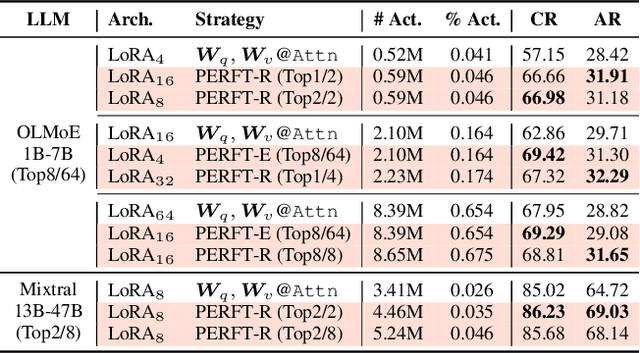

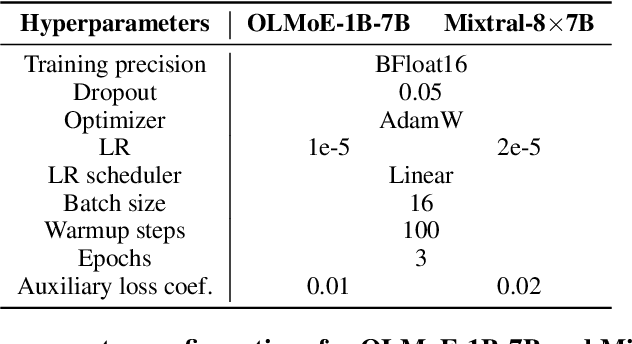
Abstract:The Mixture-of-Experts (MoE) paradigm has emerged as a powerful approach for scaling transformers with improved resource utilization. However, efficiently fine-tuning MoE models remains largely underexplored. Inspired by recent works on Parameter-Efficient Fine-Tuning (PEFT), we present a unified framework for integrating PEFT modules directly into the MoE mechanism. Aligning with the core principles and architecture of MoE, our framework encompasses a set of design dimensions including various functional and composition strategies. By combining design choices within our framework, we introduce Parameter-Efficient Routed Fine-Tuning (PERFT) as a flexible and scalable family of PEFT strategies tailored for MoE models. Extensive experiments on adapting OLMoE-1B-7B and Mixtral-8$\times$7B for commonsense and arithmetic reasoning tasks demonstrate the effectiveness, scalability, and intriguing dynamics of PERFT. Additionally, we provide empirical findings for each specific design choice to facilitate better application of MoE and PEFT.
LogLM: From Task-based to Instruction-based Automated Log Analysis
Oct 12, 2024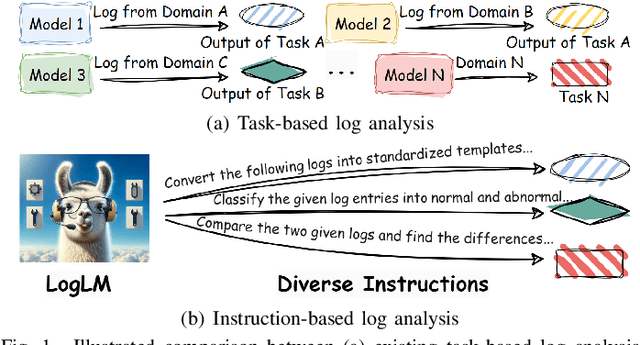
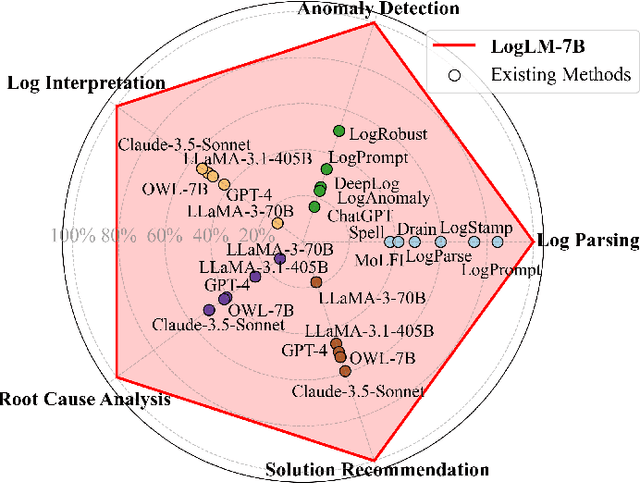


Abstract:Automatic log analysis is essential for the efficient Operation and Maintenance (O&M) of software systems, providing critical insights into system behaviors. However, existing approaches mostly treat log analysis as training a model to perform an isolated task, using task-specific log-label pairs. These task-based approaches are inflexible in generalizing to complex scenarios, depend on task-specific training data, and cost significantly when deploying multiple models. In this paper, we propose an instruction-based training approach that transforms log-label pairs from multiple tasks and domains into a unified format of instruction-response pairs. Our trained model, LogLM, can follow complex user instructions and generalize better across different tasks, thereby increasing flexibility and reducing the dependence on task-specific training data. By integrating major log analysis tasks into a single model, our approach also relieves model deployment burden. Experimentally, LogLM outperforms existing approaches across five log analysis capabilities, and exhibits strong generalization abilities on complex instructions and unseen tasks.
What Do You Want? User-centric Prompt Generation for Text-to-image Synthesis via Multi-turn Guidance
Aug 23, 2024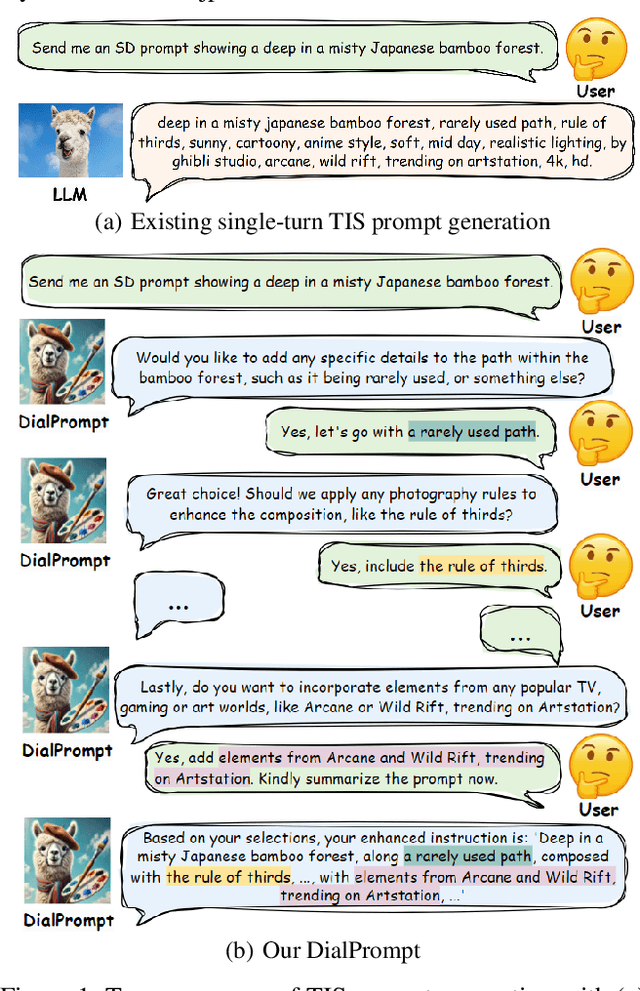
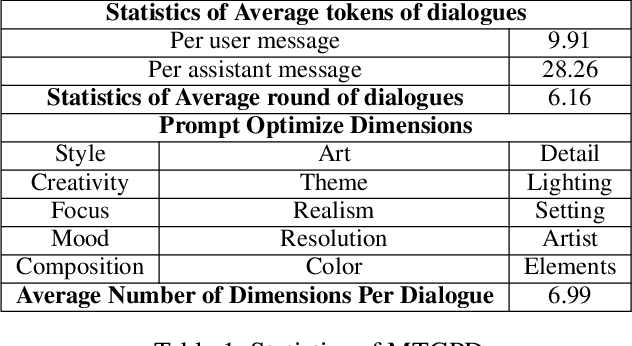
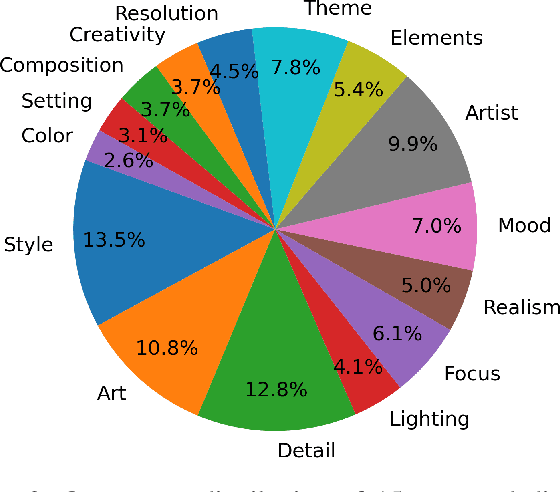
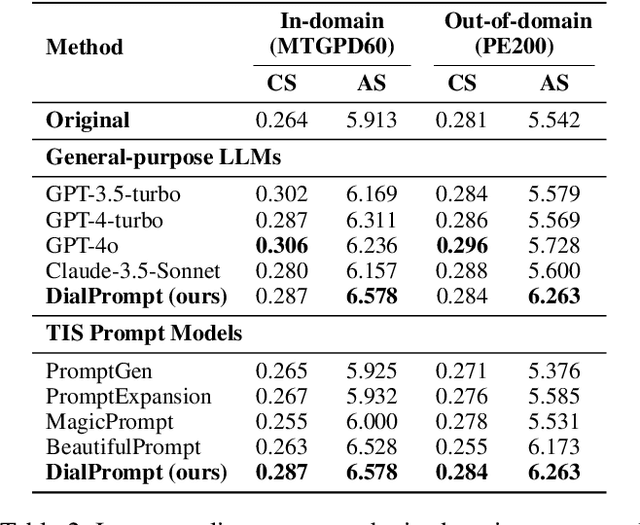
Abstract:The emergence of text-to-image synthesis (TIS) models has significantly influenced digital image creation by producing high-quality visuals from written descriptions. Yet these models heavily rely on the quality and specificity of textual prompts, posing a challenge for novice users who may not be familiar with TIS-model-preferred prompt writing. Existing solutions relieve this via automatic model-preferred prompt generation from user queries. However, this single-turn manner suffers from limited user-centricity in terms of result interpretability and user interactivity. To address these issues, we propose DialPrompt, a multi-turn dialogue-based TIS prompt generation model that emphasises user-centricity. DialPrompt is designed to follow a multi-turn guidance workflow, where in each round of dialogue the model queries user with their preferences on possible optimization dimensions before generating the final TIS prompt. To achieve this, we mined 15 essential dimensions for high-quality prompts from advanced users and curated a multi-turn dataset. Through training on this dataset, DialPrompt can improve interpretability by allowing users to understand the correlation between specific phrases and image attributes. Additionally, it enables greater user control and engagement in the prompt generation process, leading to more personalized and visually satisfying outputs. Experiments indicate that DialPrompt achieves a competitive result in the quality of synthesized images, outperforming existing prompt engineering approaches by 5.7%. Furthermore, in our user evaluation, DialPrompt outperforms existing approaches by 46.5% in user-centricity score and is rated 7.9/10 by 19 human reviewers.
LogEval: A Comprehensive Benchmark Suite for Large Language Models In Log Analysis
Jul 02, 2024
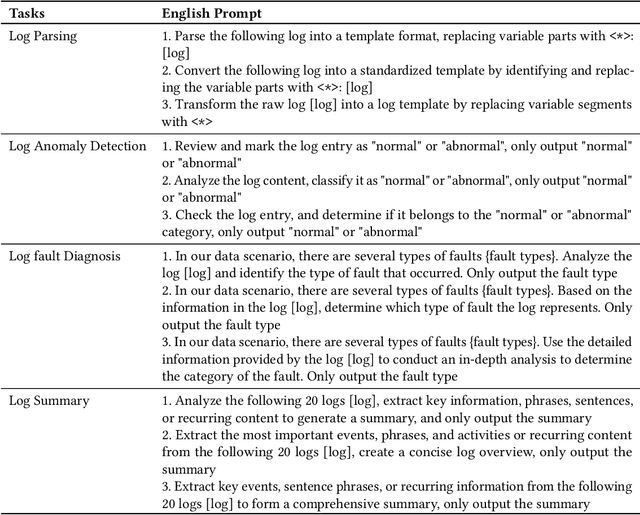
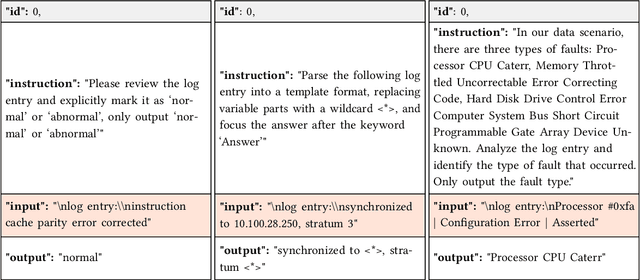
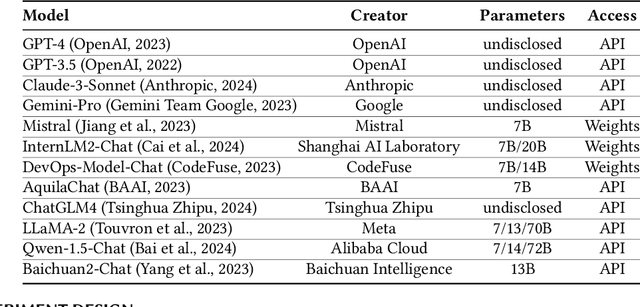
Abstract:Log analysis is crucial for ensuring the orderly and stable operation of information systems, particularly in the field of Artificial Intelligence for IT Operations (AIOps). Large Language Models (LLMs) have demonstrated significant potential in natural language processing tasks. In the AIOps domain, they excel in tasks such as anomaly detection, root cause analysis of faults, operations and maintenance script generation, and alert information summarization. However, the performance of current LLMs in log analysis tasks remains inadequately validated. To address this gap, we introduce LogEval, a comprehensive benchmark suite designed to evaluate the capabilities of LLMs in various log analysis tasks for the first time. This benchmark covers tasks such as log parsing, log anomaly detection, log fault diagnosis, and log summarization. LogEval evaluates each task using 4,000 publicly available log data entries and employs 15 different prompts for each task to ensure a thorough and fair assessment. By rigorously evaluating leading LLMs, we demonstrate the impact of various LLM technologies on log analysis performance, focusing on aspects such as self-consistency and few-shot contextual learning. We also discuss findings related to model quantification, Chinese-English question-answering evaluation, and prompt engineering. These findings provide insights into the strengths and weaknesses of LLMs in multilingual environments and the effectiveness of different prompt strategies. Various evaluation methods are employed for different tasks to accurately measure the performance of LLMs in log analysis, ensuring a comprehensive assessment. The insights gained from LogEvals evaluation reveal the strengths and limitations of LLMs in log analysis tasks, providing valuable guidance for researchers and practitioners.
GCondenser: Benchmarking Graph Condensation
May 23, 2024



Abstract:Large-scale graphs are valuable for graph representation learning, yet the abundant data in these graphs hinders the efficiency of the training process. Graph condensation (GC) alleviates this issue by compressing the large graph into a significantly smaller one that still supports effective model training. Although recent research has introduced various approaches to improve the effectiveness of the condensed graph, comprehensive and practical evaluations across different GC methods are neglected. This paper proposes the first large-scale graph condensation benchmark, GCondenser, to holistically evaluate and compare mainstream GC methods. GCondenser includes a standardised GC paradigm, consisting of condensation, validation, and evaluation procedures, as well as enabling extensions to new GC methods and datasets. With GCondenser, a comprehensive performance study is conducted, presenting the effectiveness of existing methods. GCondenser is open-sourced and available at https://github.com/superallen13/GCondenser.
CaseGNN++: Graph Contrastive Learning for Legal Case Retrieval with Graph Augmentation
May 20, 2024



Abstract:Legal case retrieval (LCR) is a specialised information retrieval task that aims to find relevant cases to a given query case. LCR holds pivotal significance in facilitating legal practitioners in finding precedents. Most of existing LCR methods are based on traditional lexical models and language models, which have gained promising performance in retrieval. However, the domain-specific structural information inherent in legal documents is yet to be exploited to further improve the performance. Our previous work CaseGNN successfully harnesses text-attributed graphs and graph neural networks to address the problem of legal structural information neglect. Nonetheless, there remain two aspects for further investigation: (1) The underutilization of rich edge information within text-attributed case graphs limits CaseGNN to generate informative case representation. (2) The inadequacy of labelled data in legal datasets hinders the training of CaseGNN model. In this paper, CaseGNN++, which is extended from CaseGNN, is proposed to simultaneously leverage the edge information and additional label data to discover the latent potential of LCR models. Specifically, an edge feature-based graph attention layer (EUGAT) is proposed to comprehensively update node and edge features during graph modelling, resulting in a full utilisation of structural information of legal cases. Moreover, a novel graph contrastive learning objective with graph augmentation is developed in CaseGNN++ to provide additional training signals, thereby enhancing the legal comprehension capabilities of CaseGNN++ model. Extensive experiments on two benchmark datasets from COLIEE 2022 and COLIEE 2023 demonstrate that CaseGNN++ not only significantly improves CaseGNN but also achieves supreme performance compared to state-of-the-art LCR methods. Code has been released on https://github.com/yanran-tang/CaseGNN.
From Handcrafted Features to LLMs: A Brief Survey for Machine Translation Quality Estimation
Mar 21, 2024Abstract:Machine Translation Quality Estimation (MTQE) is the task of estimating the quality of machine-translated text in real time without the need for reference translations, which is of great importance for the development of MT. After two decades of evolution, QE has yielded a wealth of results. This article provides a comprehensive overview of QE datasets, annotation methods, shared tasks, methodologies, challenges, and future research directions. It begins with an introduction to the background and significance of QE, followed by an explanation of the concepts and evaluation metrics for word-level QE, sentence-level QE, document-level QE, and explainable QE. The paper categorizes the methods developed throughout the history of QE into those based on handcrafted features, deep learning, and Large Language Models (LLMs), with a further division of deep learning-based methods into classic deep learning and those incorporating pre-trained language models (LMs). Additionally, the article details the advantages and limitations of each method and offers a straightforward comparison of different approaches. Finally, the paper discusses the current challenges in QE research and provides an outlook on future research directions.
Clustering and Ranking: Diversity-preserved Instruction Selection through Expert-aligned Quality Estimation
Feb 28, 2024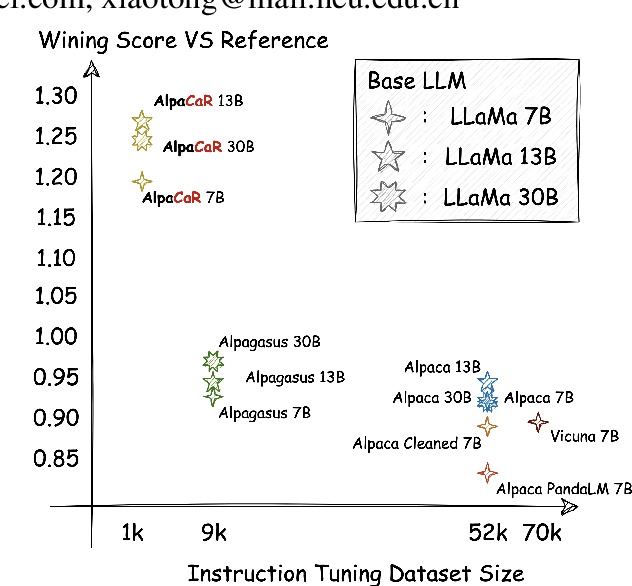

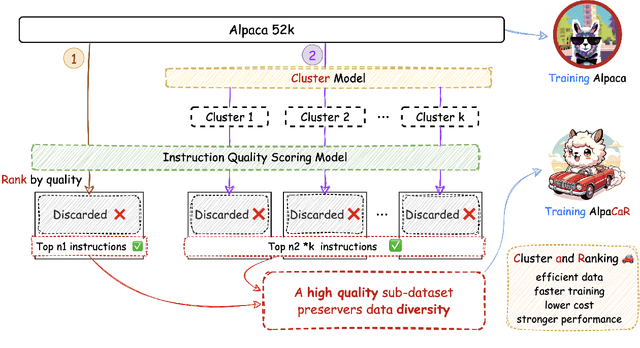
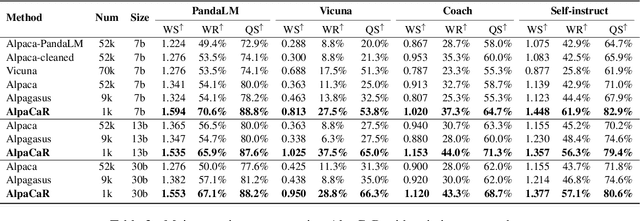
Abstract:With contributions from the open-source community, a vast amount of instruction tuning (IT) data has emerged. Given the significant resource allocation required by training and evaluating models, it is advantageous to have an efficient method for selecting high-quality IT data. However, existing methods for instruction data selection have limitations such as relying on fragile external APIs, being affected by biases in GPT models, or reducing the diversity of the selected instruction dataset. In this paper, we propose an industrial-friendly, expert-aligned and diversity-preserved instruction data selection method: Clustering and Ranking (CaR). CaR consists of two steps. The first step involves ranking instruction pairs using a scoring model that is well aligned with expert preferences (achieving an accuracy of 84.25%). The second step involves preserving dataset diversity through a clustering process.In our experiment, CaR selected a subset containing only 1.96% of Alpaca's IT data, yet the underlying AlpaCaR model trained on this subset outperforms Alpaca by an average of 32.1% in GPT-4 evaluations. Furthermore, our method utilizes small models (355M parameters) and requires only 11.2% of the monetary cost compared to existing methods, making it easily deployable in industrial scenarios.
 Add to Chrome
Add to Chrome Add to Firefox
Add to Firefox Add to Edge
Add to Edge